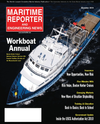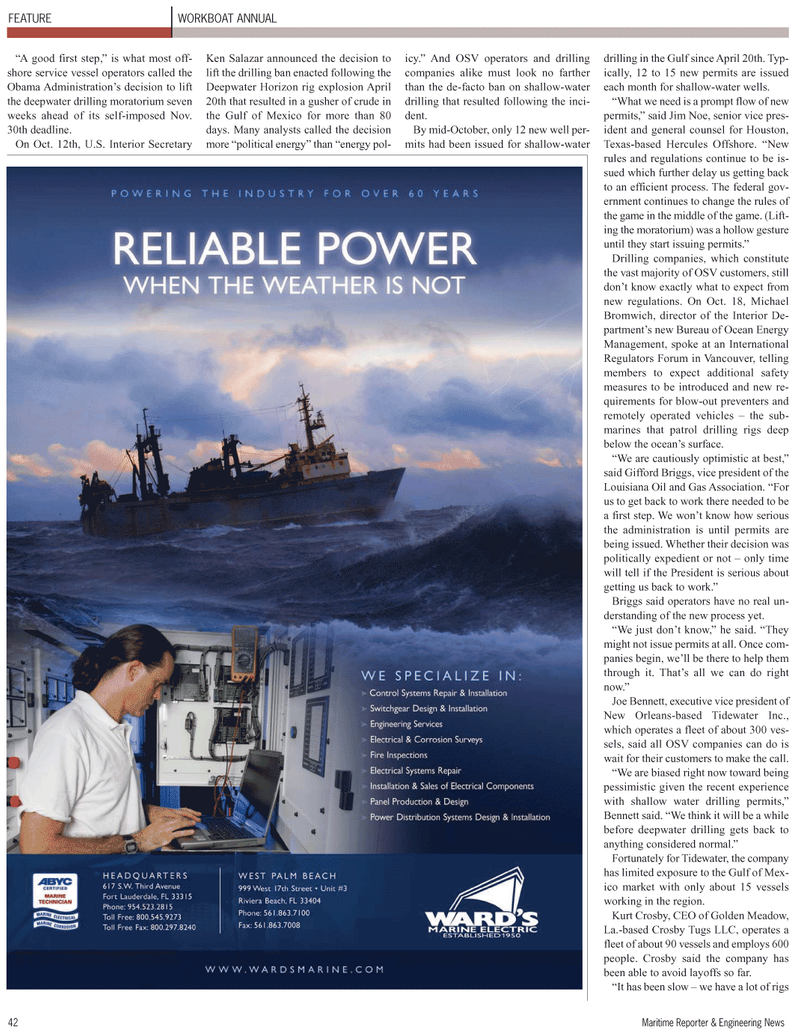
Page 42: of Maritime Reporter Magazine (November 2010)
Workboat Annual
Read this page in Pdf, Flash or Html5 edition of November 2010 Maritime Reporter Magazine
42 Maritime Reporter & Engineering News “A good first step,” is what most off- shore service vessel operators called the
Obama Administration’s decision to lift the deepwater drilling moratorium seven weeks ahead of its self-imposed Nov. 30th deadline.
On Oct. 12th, U.S. Interior Secretary
Ken Salazar announced the decision to lift the drilling ban enacted following the
Deepwater Horizon rig explosion April 20th that resulted in a gusher of crude in the Gulf of Mexico for more than 80 days. Many analysts called the decision more “political energy” than “energy pol- icy.” And OSV operators and drilling companies alike must look no farther than the de-facto ban on shallow-water drilling that resulted following the inci- dent.
By mid-October, only 12 new well per- mits had been issued for shallow-water drilling in the Gulf since April 20th. Typ- ically, 12 to 15 new permits are issued each month for shallow-water wells. “What we need is a prompt flow of new permits,” said Jim Noe, senior vice pres- ident and general counsel for Houston,
Texas-based Hercules Offshore. “New rules and regulations continue to be is- sued which further delay us getting back to an efficient process. The federal gov- ernment continues to change the rules of the game in the middle of the game. (Lift- ing the moratorium) was a hollow gesture until they start issuing permits.”
Drilling companies, which constitute the vast majority of OSV customers, still don’t know exactly what to expect from new regulations. On Oct. 18, Michael
Bromwich, director of the Interior De- partment’s new Bureau of Ocean Energy
Management, spoke at an International
Regulators Forum in Vancouver, telling members to expect additional safety measures to be introduced and new re- quirements for blow-out preventers and remotely operated vehicles – the sub- marines that patrol drilling rigs deep below the ocean’s surface. “We are cautiously optimistic at best,” said Gifford Briggs, vice president of the
Louisiana Oil and Gas Association. “For us to get back to work there needed to be a first step. We won’t know how serious the administration is until permits are being issued. Whether their decision was politically expedient or not – only time will tell if the President is serious about getting us back to work.”
Briggs said operators have no real un- derstanding of the new process yet. “We just don’t know,” he said. “They might not issue permits at all. Once com- panies begin, we’ll be there to help them through it. That’s all we can do right now.”
Joe Bennett, executive vice president of
New Orleans-based Tidewater Inc., which operates a fleet of about 300 ves- sels, said all OSV companies can do is wait for their customers to make the call. “We are biased right now toward being pessimistic given the recent experience with shallow water drilling permits,”
Bennett said. “We think it will be a while before deepwater drilling gets back to anything considered normal.”
Fortunately for Tidewater, the company has limited exposure to the Gulf of Mex- ico market with only about 15 vessels working in the region.
Kurt Crosby, CEO of Golden Meadow,
La.-based Crosby Tugs LLC, operates a fleet of about 90 vessels and employs 600 people. Crosby said the company has been able to avoid layoffs so far. “It has been slow – we have a lot of rigs
WORKBOAT ANNUALFEATURE

 41
41

 43
43
